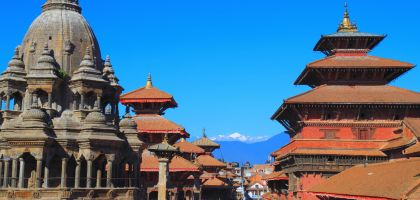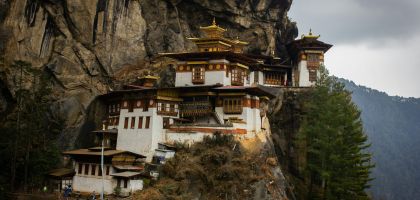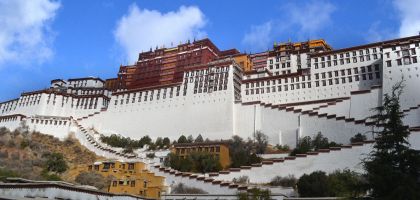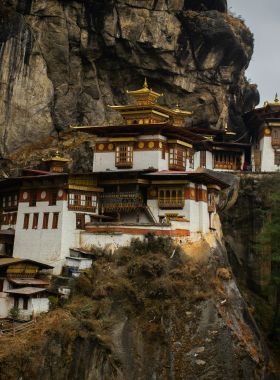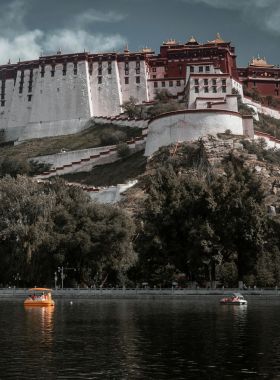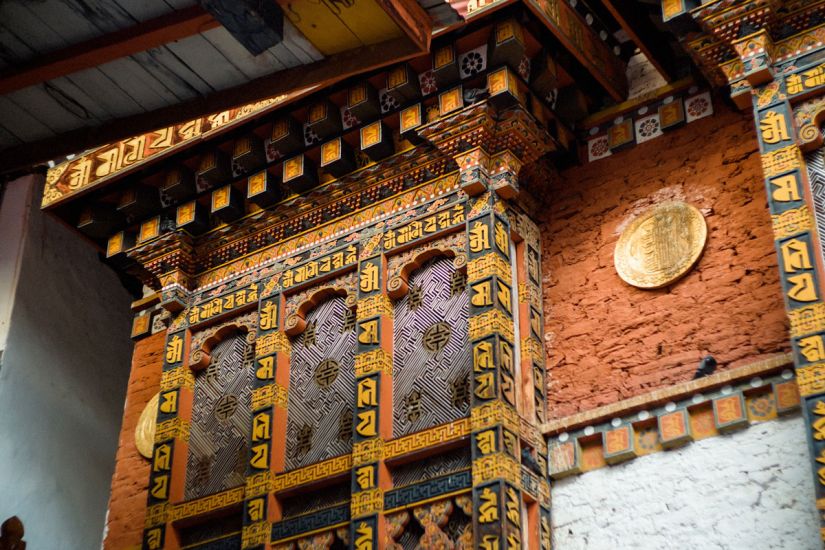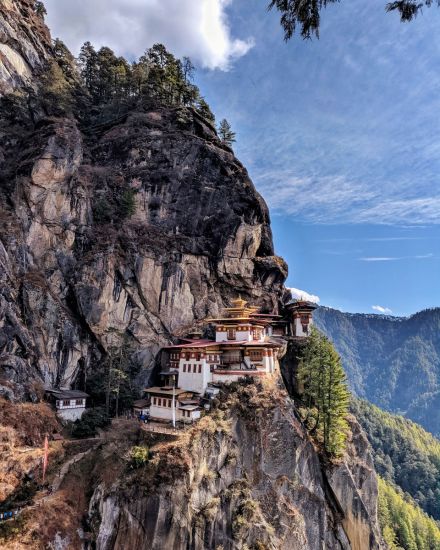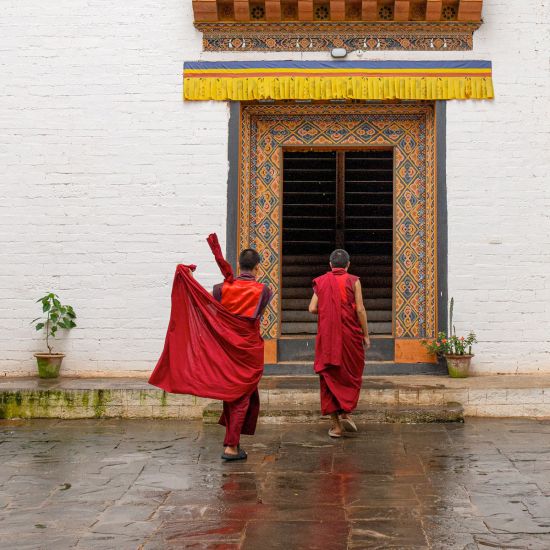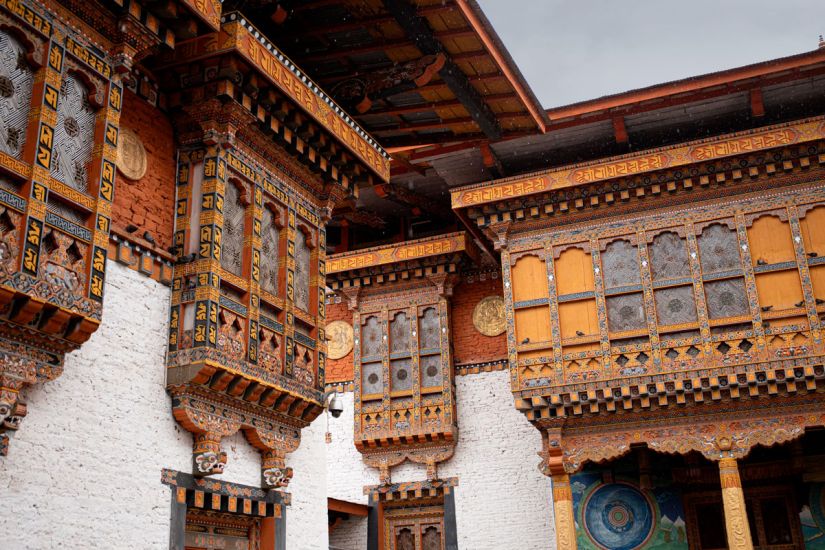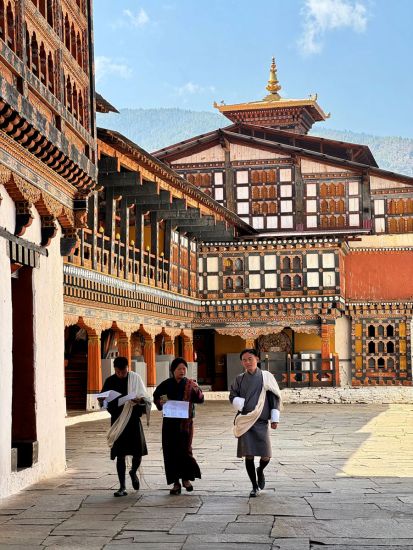Druk Path Trek
12 Days / Bhutan
Activity
Difficulty Level
Destinations
Trip Start / End
Max Altitude
Accommodation
Travel Style
Best time to travel
Personalized Travel Advice
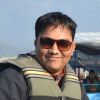
Dev Raj Nepal
+977 9851096523
Detailed Itinerary
01
DAY
01
Arrive at Paro International Airport, where you will be greeted by your guide. After completing immigration formalities, transfer to your hotel. Depending on your arrival time, take a stroll around Paro town and get a feel for Bhutanese culture. If time permits, visit Rinpung Dzong, an impressive fortress-monastery overlooking the Paro River. In the evening, enjoy a traditional Bhutanese dinner at your hotel.
Arrival in Paro
Arrive at Paro International Airport, where you will be greeted by your guide. After completing immigration formalities, transfer to your hotel. Depending on your arrival time, take a stroll around Paro town and get a feel for Bhutanese culture. If time permits, visit Rinpung Dzong, an impressive fortress-monastery overlooking the Paro River. In the evening, enjoy a traditional Bhutanese dinner at your hotel.
02
DAY
02
Today, explore Paro’s cultural and historical landmarks. Start with a visit to the National Museum, housed in a 17th-century watchtower, displaying Bhutan’s rich heritage. Continue to Kyichu Lhakhang, one of Bhutan’s oldest and most sacred temples, built in the 7th century. Next, visit Drukgyel Dzong, a historic fortress that once defended against Tibetan invasions, offering views of Mount Jomolhari (7,326m) on clear days. In the afternoon, stroll through Paro town, where you can explore local handicraft shops and cafés.
Explore Paro
Today, explore Paro’s cultural and historical landmarks. Start with a visit to the National Museum, housed in a 17th-century watchtower, displaying Bhutan’s rich heritage. Continue to Kyichu Lhakhang, one of Bhutan’s oldest and most sacred temples, built in the 7th century. Next, visit Drukgyel Dzong, a historic fortress that once defended against Tibetan invasions, offering views of Mount Jomolhari (7,326m) on clear days. In the afternoon, stroll through Paro town, where you can explore local handicraft shops and cafés.
03
DAY
03
After breakfast, embark on a hike to Taktsang Monastery, Bhutan’s most iconic landmark, perched dramatically on a cliff at 3,120m. The uphill trail winds through pine forests, with prayer flags fluttering along the path. A café halfway up provides a rest stop with breathtaking views of the monastery. Explore the sacred monastery, where Guru Rinpoche is said to have meditated in the 8th century. Descend back to Paro and spend the evening at leisure.
Excursion to Taktsang (Tiger’s Nest)
After breakfast, embark on a hike to Taktsang Monastery, Bhutan’s most iconic landmark, perched dramatically on a cliff at 3,120m. The uphill trail winds through pine forests, with prayer flags fluttering along the path. A café halfway up provides a rest stop with breathtaking views of the monastery. Explore the sacred monastery, where Guru Rinpoche is said to have meditated in the 8th century. Descend back to Paro and spend the evening at leisure.
04
DAY
04
After breakfast, embark on a hike to Taktsang Monastery, Bhutan’s most iconic landmark, perched dramatically on a cliff at 3,120m. The uphill trail winds through pine forests, with prayer flags fluttering along the path. A café halfway up provides a rest stop with breathtaking views of the monastery. Explore the sacred monastery, where Guru Rinpoche is said to have meditated in the 8th century. Descend back to Paro and spend the evening at leisure.
Trek Begins, Paro to Jela Dzong
After breakfast, embark on a hike to Taktsang Monastery, Bhutan’s most iconic landmark, perched dramatically on a cliff at 3,120m. The uphill trail winds through pine forests, with prayer flags fluttering along the path. A café halfway up provides a rest stop with breathtaking views of the monastery. Explore the sacred monastery, where Guru Rinpoche is said to have meditated in the 8th century. Descend back to Paro and spend the evening at leisure.
05
DAY
05
Today’s trek follows a ridgeline with stunning panoramic views. The trail passes through alpine forests and meadows, where you may encounter yaks grazing. As you ascend, the vegetation transitions to dwarf rhododendrons. The campsite at Jangchulakha offers spectacular sunset views over the Himalayas
Trek from Jela Dzong to Jangchulakha
Today’s trek follows a ridgeline with stunning panoramic views. The trail passes through alpine forests and meadows, where you may encounter yaks grazing. As you ascend, the vegetation transitions to dwarf rhododendrons. The campsite at Jangchulakha offers spectacular sunset views over the Himalayas
06
DAY
06
A challenging yet rewarding day, with steep ascents and descents along ridges. Enjoy sweeping views of the Himalayas, including distant peaks in Tibet. After passing through yak herder camps, arrive at Jimilangtso Lake, a serene alpine lake known for its giant trout.
Trek from Jangchulakha to Jimilangtso
A challenging yet rewarding day, with steep ascents and descents along ridges. Enjoy sweeping views of the Himalayas, including distant peaks in Tibet. After passing through yak herder camps, arrive at Jimilangtso Lake, a serene alpine lake known for its giant trout.
07
DAY
07
Continue trekking past another stunning lake, Janetso, before ascending through open ridges. Keep an eye out for blue sheep grazing on rocky slopes. The campsite at Simkota Lake is surrounded by high mountains, offering a perfect spot for stargazing.
Trek from Jimilangtso to Simkota
Continue trekking past another stunning lake, Janetso, before ascending through open ridges. Keep an eye out for blue sheep grazing on rocky slopes. The campsite at Simkota Lake is surrounded by high mountains, offering a perfect spot for stargazing.
08
DAY
08
Start the day with a gradual climb to Labana Pass (4,210m), the highest point of the trek. On clear days, you can see Mount Gangkar Puensum (7,570m), the world’s highest unclimbed peak. After soaking in the views, descend towards Phajodhing Monastery, a quiet retreat where monks engage in meditation.
Trek from Simkota to Phajodhing
Start the day with a gradual climb to Labana Pass (4,210m), the highest point of the trek. On clear days, you can see Mount Gangkar Puensum (7,570m), the world’s highest unclimbed peak. After soaking in the views, descend towards Phajodhing Monastery, a quiet retreat where monks engage in meditation.
09
DAY
09
The final day of the trek descends through forests of fir, juniper, and oak. The scent of pine fills the air as you make your way down to Motithang, near Thimphu. Your vehicle will be waiting for a short transfer to your hotel, where you can enjoy a warm shower and a well-deserved rest. Overnight in Thimphu.
Trek from Phajodhing to Motithang (Trek Ends)
The final day of the trek descends through forests of fir, juniper, and oak. The scent of pine fills the air as you make your way down to Motithang, near Thimphu. Your vehicle will be waiting for a short transfer to your hotel, where you can enjoy a warm shower and a well-deserved rest. Overnight in Thimphu.
10
DAY
10
Discover Bhutan’s capital, starting with a visit to Tashichho Dzong, the administrative and religious center of Bhutan. Continue to Buddha Dordenma, a massive golden statue overlooking the city. Visit the National Memorial Chorten, where locals gather for prayer. End the day at Centenary Farmers Market and explore handicraft shops for souvenirs.
Explore Thimphu
Discover Bhutan’s capital, starting with a visit to Tashichho Dzong, the administrative and religious center of Bhutan. Continue to Buddha Dordenma, a massive golden statue overlooking the city. Visit the National Memorial Chorten, where locals gather for prayer. End the day at Centenary Farmers Market and explore handicraft shops for souvenirs.
11
DAY
11
After breakfast, drive back to Paro, passing through scenic landscapes. Visit Dumtse Lhakhang, a rare three-story temple depicting Buddhist cosmology. Spend your final evening in Bhutan reflecting on your journey or enjoying a traditional hot stone bath.
Thimphu – Paro
After breakfast, drive back to Paro, passing through scenic landscapes. Visit Dumtse Lhakhang, a rare three-story temple depicting Buddhist cosmology. Spend your final evening in Bhutan reflecting on your journey or enjoying a traditional hot stone bath.
12
DAY
12
After breakfast, transfer to Paro International Airport for your onward journey. Take one last look at Bhutan’s pristine mountains before bidding farewell.
Departure from Paro
After breakfast, transfer to Paro International Airport for your onward journey. Take one last look at Bhutan’s pristine mountains before bidding farewell.
Includes / Excludes
Inclusions
-
Best available of the regular hotel accommodation in Paro and Thimpu.
-
All camping gears that includes-2 person sleeping tents with floors and fly sheet, dinning tent, kitchen tent, toilet tents, dinning tables, chairs, pillows and mattresses.
-
English speaking Guide.
-
Cook and kitchen aides.
-
All intercity transfers and sightseeing by a private vehicle.
-
Pack animals and animal drivers during trekking.
-
All necessary supplies.
-
3 meals a day.
-
Bhutan visa.
-
Entrance fees.
Exclusions
-
International airfares.
-
Travel Insurance.
-
Expenses of personal nature like drinks, tip, telephone, laundry etc.
-
Extra expenses due to nature or unforeseen events such as flight cancellation, road blockade, no show etc.
Trip Info
he best time to do the Druk Path Trek in Bhutan is during the spring (March to May) and autumn (September to November) months. These seasons offer the most favorable weather conditions for trekking.
Spring (March to May): The temperatures are mild, and the landscape comes alive with vibrant rhododendron blooms and alpine flowers. The skies are generally clear, offering excellent views of the Himalayan peaks.
Autumn (September to November): This season provides crisp, clear weather, ideal for trekking with spectacular mountain vistas. The air is dry and cool, and it’s a great time for trekking as the monsoon rains have subsided, leaving the trails clear and the views crisp.
Both seasons offer stable weather, with less chance of rain, and optimal conditions for trekking at high altitudes. Winter (December to February) is cold, with heavy snow, making the trek more challenging, while summer (June to August) brings heavy monsoon rains, which can make the trail slippery and muddy.
For this tour, we prioritize both comfort and safety by providing well-maintained vehicles suited to the group size. If the group consists of fewer than 8 participants, we will use a high-roof Toyota HiAce, a spacious and reliable vehicle with ample legroom and luggage space. For groups larger than 8, we will upgrade to a Mini-bus, ensuring everyone has a comfortable and enjoyable journey together.
Our drivers are highly experienced professionals with extensive knowledge of the routes, terrain, and road conditions. They are trained in defensive driving and safety protocols, ensuring a smooth and secure travel experience. With years of experience navigating mountain roads and varying weather conditions, they prioritize passenger safety while maintaining a steady and comfortable ride.
Additionally, our vehicles undergo regular maintenance and safety checks to ensure reliability throughout the journey. Whether winding through mountain passes or traveling along scenic valleys, you can rest assured that your transportation is in capable hands, allowing you to fully enjoy the beauty of the destination without any worries.
Most parts of this trek will take you to the remote regions of Bhutan. Therefore, there is a scarcity of luxurious accommodations. At regional centers and big towns like Paro and Thimphu, we provide high grade hotels that provide comfort and warmth. However, during the trek, the accommodations are primarily in tents, where trekkers camp in designated spots at various points along the trail. These campsites are typically set up in meadows or near small villages, offering trekkers a chance to experience the beauty of the highlands up close. The camps are equipped with basic facilities like sleeping tents and shared dining tents, where meals are served. In some places, trekkers can stay in simple guesthouses or hotels that provide comfort before and after the trek. The accommodations are functional and designed to complement the trekking experience, offering a cozy respite after a long day on the trail.
Food on this typical Bhutan trek is mostly simple but nutritious, designed to provide energy for the long days of trekking. In the villages and towns, meals are typically served at local guesthouses, where you’ll find traditional Bhutanese dishes such as ema datshi (a spicy cheese and chili dish) and phaksha paa (pork with radishes). During the trek, meals are often prepared by the trek crew, including porters and cooks, and served at the campsites. Expect to have a variety of hearty, locally sourced food, such as rice, vegetables, lentils, and noodles. Breakfast may include porridge, eggs, and bread, while dinners often consist of stews and curries. Given the high-altitude conditions, hydration is crucial, and water is regularly provided during the trek, though it’s recommended to drink purified water.
Clothing
- Light layers: T-shirts, long-sleeve shirts, and a couple of warm sweaters or fleeces.
- Thermal wear: Necessary for high-altitude areas and trekking days (especially for evenings).
- Outerwear: Warm, windproof jacket; waterproof jacket or poncho (for unexpected rain).
- Pants: Comfortable trekking pants and a few pairs of casual pants for cultural sites and town visits.
- Comfortable shoes: Hiking boots for trekking and sturdy, comfortable walking shoes for towns.
- Warm socks: Especially for trekking days at higher altitudes.
Accessories
- Hat, gloves, and scarf
- Sun hat and sunglasses
- Light daypack
- Trekking poles
- Quick-dry towel
Personal Items
- Toiletries: Soap, shampoo, toothbrush, toothpaste, and other personal hygiene items.
- Sunscreen and lip balm: High SPF for sun protection at high altitudes.
- Moisturizer: Dry weather may affect the skin.
- Hand sanitizer and wet wipes: For cleanliness on the go.
- First aid kit: Basic items like band-aids, pain relievers, blister treatment, altitude sickness medication (consult a doctor before traveling).
- Insect repellent: For rural areas.
Trekking Essentials
- Reusable water bottle
- Water purification tablets
- Energy snacks
- Headlamp or flashlight
Cultural Considerations
- Modest clothing: Long pants and long-sleeved shirts are preferred for monastery visits.
- Shawl or scarf: Useful when entering temples or Dzongs.
- Reusable bags: For storing and organizing belongings.
Risks:
Altitude Sickness: As the trek reaches altitudes of over 3,000 meters, altitude sickness can be a concern, especially for those not accustomed to high elevations. Symptoms include headaches, nausea, and dizziness. It’s crucial to acclimatize properly by taking regular rest days.
Weather Conditions: Weather in the Himalayas can be unpredictable. Sudden rainstorms, snow, or temperature drops can occur, especially during the monsoon and winter months. This could make the trail slippery and challenging.
Rugged Terrain: While the trek is moderate, some sections can be steep and rocky, particularly in the higher altitudes. This requires good physical fitness and careful footing, especially during wet or snowy conditions.
Limited Trail Accessibility: Although the trail has exit points, some sections of the Druk Path Trek may be difficult to access by road. It’s essential to have proper planning and support to avoid unexpected complications. Furthermore, the trek takes you through remote areas with limited access to medical facilities. In case of injury or health issues, evacuation can be time-consuming and challenging.
Rewards:
Stunning Himalayan Views: The Druk Path Trek offers unparalleled views of some of Bhutan’s highest peaks, including Jomolhari (7,326m) and Gangkar Puensum (7,570m). These majestic mountains are the reward for pushing through the physical challenges of the trek.
Rich Cultural Immersion: The trek takes you past historic Dzongs, monasteries, and temples, allowing you to immerse yourself in Bhutan’s rich spiritual and cultural heritage. Visiting Taktsang Monastery (Tiger’s Nest) and other sacred sites is a unique opportunity.
Remote Wilderness: Trekking through untouched landscapes, you’ll encounter pristine alpine lakes, forests, and wildlife. This sense of seclusion is one of the great rewards of trekking in Bhutan’s rugged wilderness.
Physical and Mental Achievement: Successfully completing the trek is a rewarding experience in itself. The challenges of high-altitude trekking, physical endurance, and perseverance all contribute to a sense of accomplishment.
Spiritual Experience: The trek offers moments of introspection, especially when visiting sacred monasteries and walking through remote areas. The peaceful and serene environment provides a unique opportunity for personal reflection.
Breathtaking Scenery and Culture
Expect to be surrounded by some of the most beautiful landscapes in the world. The trek takes you through dense forests, rolling hills, alpine meadows, and pristine lakes, with panoramic views of the snow-capped Himalayan peaks like Jomolhari and Gangkar Puensum. The beauty of the natural surroundings will constantly inspire awe. Additionally, Bhutan is a deeply spiritual country, and on this trek, you’ll encounter traditional Bhutanese culture in every step. Visit ancient Dzongs, monasteries, and sacred sites like Taktsang Monastery (Tiger’s Nest), where you’ll get a glimpse into the nation’s Buddhist traditions. The warm hospitality of the Bhutanese people will also be a memorable part of your journey.
High-Altitude and Wilderness
While the trek is moderate in difficulty, expect to face the challenges of high-altitude trekking. The initial climbs can be strenuous, but once you acclimatize, the route becomes more manageable. Keep in mind that the thin air at higher elevations can make breathing more difficult, and altitude sickness may be a concern if proper precautions aren’t taken. Expect to spend most of your time away from modern conveniences. The trek takes you through remote and rugged terrain, where you’ll camp in scenic spots and enjoy the serenity of nature. This sense of seclusion is a welcome escape from busy city life, but also means limited access to services, so be prepared to be self-sufficient.
Physical Endurance and Limited Infrastructure
While not extremely difficult, the Druk Path Trek requires good physical fitness. Prepare for long hiking days with moderate to steep climbs and descents. Some sections of the trail may be rocky or muddy, depending on the weather. The physical effort involved will be rewarded by the stunning landscapes and the sense of accomplishment. During any trek in Bhutan, you won’t find the same level of infrastructure as in urban areas. Accommodations will generally be in basic camping setups or local guesthouses, offering a rustic and authentic experience. While the facilities will be comfortable, you should be ready for simplicity and self-reliance during the trek.
Weather Variability and Spiritual Reflection
Expect the weather to be unpredictable, especially in the higher altitudes. While spring and autumn offer the best conditions, you may still encounter sudden rain, wind, or snow, depending on the season. Be prepared for cold temperatures, especially at night, and ensure your gear is suitable for fluctuating weather conditions. Despite the challenges, trekking in Bhutan is not just about physical adventure, but also a spiritual journey. The tranquility of the surroundings, combined with visits to sacred Buddhist sites, provides a chance for personal reflection and connection with the region’s spiritual atmosphere.
FAQs
Personalized Travel Advice

Dev Raj Nepal
+977 9851096523
